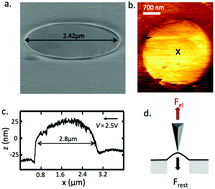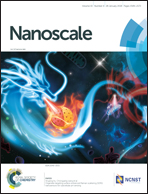Low-force spectroscopy on graphene membranes by scanning tunneling microscopy†
Abstract
Two-dimensional atomically flat sheets with a high mechanical flexibility are very attractive as ultrathin membranes but are also inherently challenging for microscopic investigations. We report on a method using Scanning Tunneling Microscopy (STM) under ultra-high vacuum conditions for non-indenting low-force spectroscopy on micrometer-sized freestanding graphene membranes. The method is based on applying quasi-static voltage ramps with active feedback at low tunneling currents and ultimately relies on the attractive electrostatic force between the tip and the membrane. As a result a bulge-test scenario can be established. The convenience and simplicity of the method relies on the fact that the loading force and the membrane deflection detection are both provided simultaneously by the STM. This permits the continuous measurement of the stress–strain relation. Electrostatic forces applied are typically below 1 nN and the membrane deflection is detected at sub-nanometer resolution. Experiments on single-layer graphene membranes with a strain of 0.1% reveal a two-dimensional elastic modulus E2D = 220 N m−1.

- This article is part of the themed collection: Nanoscale Most Popular Articles


 Please wait while we load your content...
Please wait while we load your content...